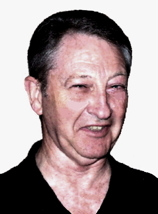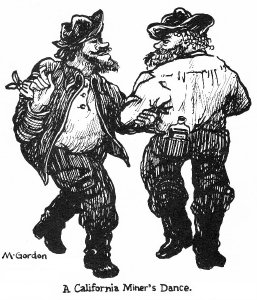
|
Folk Dance Federation of California, South, Inc.
|

|
CLICK IMAGE TO ENLARGE
 Everyone knows that dance was important to the Indians of the Old West. For them, it was a religious ritual, tied to their perception of the spirits of war and wealth.
Everyone knows that dance was important to the Indians of the Old West. For them, it was a religious ritual, tied to their perception of the spirits of war and wealth.
The European-Americans who moved into the Indian Territory – and created what we now call "the Old West" – danced, too. They danced at every opportunity, but they danced for purely social and recreational reasons, adapting their dances under the pressures of frontier life into uniquely American folk dances, very differeent from the so-called "Country Western" dance of today.
Consider who these people were; farmers from rocky, worn-out farms of New England and Appalachia; Southerners from a destroyed South; restless youth from crowded Eastern cities; gold-seekers and adventurers from everywhere, all scattered over a land two thousand miles wide and two thousand miles high.
For most, life was hard and riches were only a dream and, like the land-bound European peasant, dance became an important form of socializing; dance is cheap and ready entertainment for improverished folk and it appears in almost every folk culture on earth.
Since most of the original White immigrants were of Northern European origin, the dances they brought with them were European couple dances; the Germans brought the waltz and mazurka and schottische; the Czechs the polka; the New Englanders their lancers; the Appalachian farmers brought their clog and Big Circle Dance and the Kentucky Running Set. The ingredients were all there and they proceeded to combine them to suit their own needs and tastes.
The waltz and polka and mazurka remained pretty much unchanged, except perhaps not quite as refined as in the East – rough-hewn men willingly took the part of women in the dance (women were scarce and more rarely unattached). A gent would tie a scarf around his arm or don an apron to designate his role as being one of the "fairer sex," and off a-waltzing he would go with an equally grubby fellow cowboy or miner.
The European couple dances were quickly adopted by the Mexican population along the border and delightful Mexican versions of the waltz, polka, and schottische are still popular today.
But the set dances – and the quadrilles – were greatly altered to suit the needs of the time and place. The New England "lancer" and "contra" had evolved from old English Country Dances into a highly formalized quadrille form with a rehearsed seuence of figures contrived by a professional dance master. Widely scattered cowboys could no way learn and remenber the sequences from one dance to another, so that didn't work.
What did work was the Appalachian Big Circle dance and the Kentucky Running Set, with their called figures. Combined with the quadrille, the figures evolved into what we now call the "square dance," our "national dance," and one of the most well-known images of America throughout the world.
Used with permission of the author.